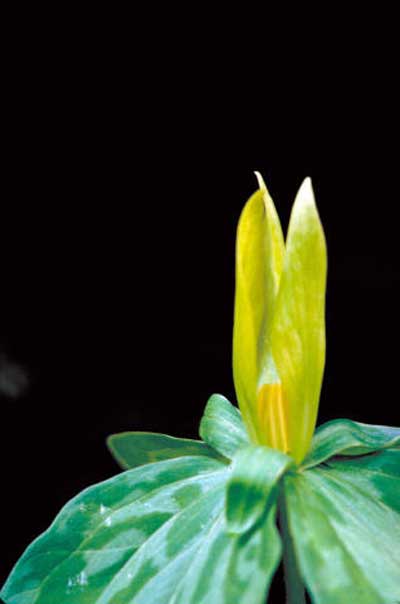
Trillium luteum. Photo: U.S. Fish and Wildlife Service
Classification System: APG IV
Superregnum: Eukaryota
Regnum: Plantae
Cladus: Angiosperms
Cladus: Monocots
Ordo: Liliales
Familia: Melanthiaceae
Tribus: Parideae
Genus: Trillium
Species: Trillium luteum
Name
Trillium luteum Harb., 1901
References
Harbison, T.G., 1901: Biltmore Botanical Studies 1:21
Vernacular names
English: Yellow wakerobin
Trillium luteum, the yellow trillium[3][4] or yellow wakerobin,[5] is a species of flowering plant in the bunchflower family Melanthiaceae with native populations in the Great Smoky Mountains of the United States and surrounding areas.[3]
Description
Growing to 40 cm (16 in) tall by 30 cm (12 in) wide, it is a woodland herbaceous perennial flowering in spring, with lemon yellow scented blooms. The large stalkless triple leaves often have grey-green marbling on the surface. It flowers in April-May beneath the bare branches of deciduous trees.[6] After flowering and setting seed it goes dormant in summer, before appearing again in late winter.
Taxonomy
Trillium luteum was first described by Muhlenberg in 1813 as T. sessile var. luteum but the taxon was later given specific rank by Harbison.[7] Given this history, it's not surprising that T. luteum is often sold under the name of T. sessile var. luteum, which has caused some confusion. It has also been known as T. cuneatum var. luteum (Muhl.) H.E. Ahles and T. viride var. luteum (Muhl.) Gleason.[8]
Distribution
Trillium luteum has interbred extensively with T. cuneatum in its native range, forming numerous intermediate hybrids. Moreover, botanists in the past have confused it with the more western T. viride. It is therefore sometimes difficult to determine the true range of purebred T. luteum specimens. The main population appears to reside in Eastern Tennessee, extending into North Carolina and Georgia. It is especially abundant around Gatlinburg. The species also occurs in Kentucky, and in scattered locations farther north, in Ontario, Michigan, Pennsylvania, Maryland and northern Virginia, but these appear to be naturalized populations.[9]
Cultivation
Though hardy down to −15 °C (5 °F), this plant requires a sheltered position with rich, moist leafmould in a shaded, deciduous woodland setting which mimics its native habitat in North American broadleaf forests. It must be left undisturbed to grow into a large colony. It requires some experience to grow successfully, but nevertheless has gained the Royal Horticultural Society's Award of Garden Merit.[10][11]
References
"Trillium luteum". NatureServe Explorer. NatureServe. Retrieved 16 November 2021.
Kew World Checklist of Selected Plant Families
Case Jr., Frederick W. (2002). "Trillium luteum". In Flora of North America Editorial Committee (ed.). Flora of North America North of Mexico (FNA). 26. New York and Oxford – via eFloras.org, Missouri Botanical Garden, St. Louis, MO & Harvard University Herbaria, Cambridge, MA.
Pistrang, Mark. "Yellow Trillium (Trillium luteum)". United States Forest Service. Retrieved 15 July 2019.
"Trillium luteum". Natural Resources Conservation Service PLANTS Database. USDA. Retrieved 15 December 2015.
RHS A-Z encyclopedia of garden plants. United Kingdom: Dorling Kindersley. 2008. p. 1136. ISBN 978-1405332965.
Harbison, T. G. (1901). "New or little known species of Trillium". Biltmore Botanical Studies. 1 (1): 21–22. Retrieved 7 October 2019.
"Trillium luteum". Integrated Taxonomic Information System.
Biota of North America Program 2014 county distribution map
"RHS Plant Selector - Trillium luteum". RHS. Retrieved 5 March 2021.
"AGM Plants - Ornamental" (PDF). Royal Horticultural Society. November 2018. Retrieved 17 August 2019.
Further reading
Case, Frederick W. and Case, Roberta B. (1997) Trilliums. ISBN 0-88192-374-5
Retrieved from "http://en.wikipedia.org/"
All text is available under the terms of the GNU Free Documentation License

